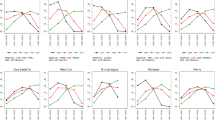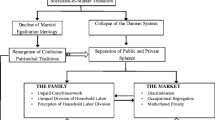Abstract
This article proposes a new way of looking at social inequality in socialist and nonsocialist societies. In the first section, a conceptual framework for recovering houseworkers for class analysis is introduced, and a historically-based argument for representing them in the occupational structure is advanced. The second section reviews the evolution of social cleavages from the preindustrial era to the present day and discusses the implications of using the same occupational classification scheme to describe both socialist and nonsocialist societies. This occupational classification is illustrated in the concluding section of the paper by reanalyzing data from Hungary and the United States. The results provide new insights into the structure of gender-based inequalities and the effects of socialism on the occupational division of labor.
Similar content being viewed by others
References
Aminzade, Ronald, andRandy Hodson 1982 “Social mobility in a mid-nineteenth century French city.” American Sociological Review 47:441–457.
1984 Fertility. Female Employment, and Policy Measures in Hungary. Geneva: International Labour Organization.
1985 “Hungary.” In Valentina Bodrova and Richard Anker (eds.), Working Women in Socialist Countries. Geneva: International Labour Organisation.
1962 “The breakup of family capitalism.” In The End of Ideology. New York: Free Press.
1976 The Coming of Post-Industrial Society. New York: Basic Books.
Bianchi, Suzanne M., andDaphne Spain 1980 American Women in Transition. New York: Russell Sage.
Blau, Peter M., andOtis Dudley Duncan 1967 The American Occupational Structure. New York: Free Press.
Böröcz, József 1989 “Mapping the class structures of state socialism in East-Central Europe.” In Research in Social Stratification and Mobility, Vol. 8:279–309. Greenwich, CT: JAI Press.
Braverman, Harry 1974 Labor and Monopoly Capital. New York: Monthly Review Press.
Burawoy, Michael 1979 Manufacturing Consent. Chicago: University of Chicago Press.
Burnham, James 1962 The Managerial Revolution. Bloomington: Indiana University Press.
Cain, Pamela S., andDonald J. Treiman 1981 “The Dictionary of Occupational Titles as a source of occupational data.” American Sociological Review 46:253–278.
Cherlin, Andrew J. 1981 Marriage, Divorce, Remarriage. Cambridge, MA: Harvard University Press.
Cliff, Tony 1974 State Capitalism in Russia. London: Pluto Press.
Connell, Robert W., andT. H. Irving 1973 “Yes, Virginia, there is a ruling class.” In Henry Meyer and Helen Nelson (eds.), Australian Politics: 31–47. Melbourne: Cheshire.
Crozier, Michel 1964 The Bureaucratic Phenomenon. Chicago: University of Chicago Press.
Dahrendorf, Ralf 1959 Class and Class Conflict in Industrial Society. Stanford, CA: Stanford University Press.
Davies, Margery W. 1982 Woman's Place Is at the Typewriter. Philadelphia, PA: Temple University Press.
Davis, James Allen, andTom W. Smith 1987 General Social Survey, 1972–1987 [machine readable data file]. Chicago: National Opinion Research Center, producer, 1987; Storrs, CT: The Roper Center for Public Opinion Research, University of Connecticut, distributor.
Davis, Kingsley 1984 “Wives and work: The sex role revolution and its consequences.” Population and Development Review 10:397–417.
Davis, Kingsley, andWilbert E. Moore 1966 “Some principles of stratification.” In Reinhard Bendix and Seymour M. Lipset (eds.), Class, Status, and Power: 47–52. New York: Free Press.
Djilas, Milovan 1957 The New Class. New York: Harcourt Brace Jovanovich.
Edwards, Richard 1979 Contested Terrain. New York: Basic Books.
Erikson, Robert 1984 “Social class of men, women, and families.” Sociology 18:500–514.
Erikson, Robert, andJohn H. Goldthorpe 1988 “Women at class crossroads: A critical note.” Sociology 22:545–553.
Erikson, Robert, John H. Goldthorpe, andLucienne Portocarero 1979 “Intragenerational class mobility in three Western European societies: England, France, and Sweden.” British Journal of Sociology 30:415–441.
Featherman, David L., andRobert M. Hauser 1978 Opportunity and Change. New York: Academic Press.
Ferge, Zsuzsa 1983 “Változik-e manapság a nők helyzete?” (Has the situation of women changed lately?) In A. Olajos (ed.), Tanulmányok a Női Munkáról (Studies on Women's Work): 230–255. Budapest: Kossuth Könyvkiadó.
Fox, Mary Frank, andSharlene Hesse-Biber 1984 Women at Work. New York: Mayfield Publishing Company.
Fuchs, Victor R. 1988 Women's Quest for Economic Equality. Cambridge, MA: Harvard University Press.
Gagliani, Giorgio 1981 “How many working classes?” American Journal of Sociology 87:259–285.
Giddens, Anthony 1973 The Class Structure of the Advanced Industrial Societies. London: Hutchinson.
1980 Social Mobillty and Class Structure in Modern Britain. Oxford: Clarendon Press.
1983 “Women and class analysis: In defense of the conventional view.” Sociology 17:465–488.
1987 Social Mobility and Class Structure in Modern Britain, 2nd ed. Oxford: Clarendon Press.
Gouldner, Alwin W. 1979 The Future of Intellectuals and the Rise of the New Class. New York: Macmillan.
Haraszti, Miklós 1978 A Worker in a Worker's State. New York: Universe Books.
1983 Social Mobility and Life History Survey, 1983 [machine readable data file]. Budapest: Hungarian Central Statistical Office, producer and distributor.
1986 Társadalmi Mobilitás és Presztizs (Social Mobility and Prestige). Budapest: Központi Statisztikai Hivatal.
Hechter, Michael, andWilliam Brustein 1980 “Regional modes of production and patterns of state formation in Western Europe.” American Journal of Sociology 85:1061–1094.
Johnson, Terence J. 1972 Professions and Power. London: Macmillan.
Kanter, Rosabeth Moss 1977 Men and Women of the Corporation. New York: Basic Books.
Katz, Michael B., Michael J. Doucet, andMark J. Stern 1982 The Social Organization of Early Industrial Capitalism. Cambridge, MA: Harvard University Press.
1981 Women Have Always Worked. New York: Feminist Press.
1982 Out to Work: A History of Wage-Earning Women in the United States. Oxford: Oxford University Press.
Konrád, Georg, andIván Szelényi 1979 The Intellectuals on the Road to Class Power. New York: Harcourt Brace Jovanovich.
1986a “The Hungarian reform progress: Visions, hopes, and reality.” Journal of Economic Literature 24:1687–1737.
1986b Contradictions and Dilemmas: Studies on the Socialist Economy and Society. Cambridge, MA: MIT Press.
Larson, Magali Sarfatti 1977 The Rise of Professionalism. Berkeley: University of California Press.
Lazerson, Mark H. 1988 “Organizational growth of small firms: An outcome of markets and hierarchies?” American Sociological Review 53:330–342.
Lerner, Gerda 1979 “Just a housewife.” In Gerda Lerner (ed.), The Majority Finds Its Past: 129–144. Oxford: Oxford University Press.
Lockwood, David 1958 The Blackcoated Worker. London: George Allen and Unwin.
Marglin, Stephen 1982 “What do the bosses do? The origins and functions of hierarchy in capitalist production.” In Anthony Giddens and David Held (eds.), Classes, Power, and Conflict: 285–298. Berkeley: University of California Press.
Márkus, György 1983 “Corporate property and command economy.” In Ferenc Fehér, Aǵnes Heller, and György Márkus (eds.), Dictatorship Over Needs: 45–105. Oxford: Basil Blackwell.
Marx, Karl 1952 Manifesto of the Communist Party. (1848*) Moscow: Progress.
Matthaei, Julie A. 1982 An Economic History of Women in America. New York: Schocken.
McLaughlin, Steven D., Barbara D. Melber, John O. G. Billy, Denise M. Zimmerle, Linda D. Winges, andTerry R. Johnson 1988 The Changing Lives of American Women. Chapel Hill: University of North Carolina Press.
Meyer, John W., Francisco O. Ramirez, Henry A. Walker, Nancy Langton, andSorca M. O'Connor 1988 “The state and the institutionalization of the relations between women and children.” In Sanford M. Dornbusch and Myra H. Strober (eds.), Feminism, Children: 137–160, and the New Families. New York: Guilford Press.
Mills, C. Wright 1951 White Collar. London: Oxford University Press.
Moore, Wilbert E. 1963 Social Change. Englewood Cliffs, NJ: Prentice-Hall.
Orolin, Zsuzsa 1983 “A nők foglalkoztatásának szoiálpolitikai vonatkozásai” (The sociopolitical consequences of women's employment). In A. Olajos (ed.), Tanulmányok női Munkáról (Studies on Women's Work): 53–65. Budapest: Kossuth Könyvkadó.
1971 Class Inequality and Political Order. New York: Praeger.
1979 Marxism and Class Theory: A Bourgeois Critique. New York: Columbia University Press.
Parsons, Talcott, andRobert F. Bales 1955 Family, Socialization, and Interaction Process. Glencoe, IL: Free Press.
Peers, Jo 1985 “Workers by the hand and womb: Soviet women and the demographic crisis.” In Barbara Holland (ed.), Soviet Sisterhood. Bloomington, INkk: Indiana University Press.
Piore, Michael J., andCharles F. Sabel 1984 The Second Industrial Divide. New York: Basic Books.
Portes, Alejandro, andSaskia Sassen-Koob 1987 “Making it underground: Comparative material on the informal sector in Western market economies.” American Journal of Sociology 93:30–61.
Roos, Patricia A. 1985 Gender and Work. New York: State University of New York Press.
Rueschemeyer, Marilyn, andSzonja Szelényi 1989 “Socialist transformation and gender inequality: Women in the German Democratic Republic and in Hungary.” In D. Childs, T. A. Baylis, and M. Rueschemeyer (eds.), East Germany in Comparative Perspective: 81–109. London: Routledge.
Schachtman, Max 1962 The Bureaucratic Revolution. New York: Donald Press.
Simkus, Albert A., andRudolf Andorka 1982 “Inequalities in educational attainment in Hungary, 1923–1973.” American Sociological Review 47:740–751.
Starr, Paul 1982 The Social Transformation of American Medicine. New York: Basic Books.
Stone, Katherine 1981 “The origins of job structures in the steel industry.” In Mary Zey-Ferrell and Michael Aiken (eds.), Complex Organizations: Critical Perspectives: 349–381. Glenview, IL: Scott, Foresman and Company.
Szelényi, Iván 1988 Socialist Entrepreneurs: Embourqeoisement in Rural Hungary. Madison, WI: University of Wisconsin Press.
1987 “Social inequality and party membership: Patterns of recruitment into the Hungarian Socialist Workers' Party.” American Sociological Review 52:559–573.
1988 Social mobility and class structure in Hungary and the United States.” Dissertation, Department of Sociology, University of Wisconsin, Madison. Ann Arbor, MI: University Microfilms, No. 8826077.
Szelényi, Szonja, and Karen E. Aschaffenburg forthcoming “Inequalities in educational opportunity: Changes in socialist Hungary.” In Y. Shavit and H. Blossfeld (eds.), Persistent Inequality: Changing Educational Stratification in Thirteen Countries. Boulder, CO: Westview Press.
Teitelbaum, Michael S., andJay M. Winter 1985 Fear of Population Decline. New York: Academic Press.
Tilly, Charles 1981 As Sociology Meets History. New York: Academic Press.
Tilly, Louise A., andJoan W. Scott 1978 Women, Work, and Family. New York: Holt, Rinehart, and Winston.
Treiman, Donald J. 1970 “Industrialization and social stratification.” In Edward O. Laumann (ed.), Social Stratification: 207–234. New York: Bobbs-Merrill.
Turgonyi, Júlia, andZsuzsa Ferge 1969 Az Ipari Munkasnők Munka- és Életkörülményei (The Work- and Life-Situations of Female Industrial Workers). Budapest: Kossuth Könyvkiadó.
U.S. Bureau of the Census 1971 Alphabetical Index of Industries and Occupations, 1970 Census of Population. Washington, DC: U.S. Government Printing Office.
U.S. Department of Labor 1977 Dictionary of Occupational Titles. Washington, DC: U.S. Government Printing Office.
Utasi, Agnes 1984 “Life styles, demand levels, and Hungary's elite.” In Rudolf Andorka and Tamás Kolosi (eds.), Stratification and Inequality: 137–156. Budapest: Institute for Social Sciences.
Weber, Max 1978 Economy and Society, (1922). Berkeley: University of California Press.
Wolchik, Sharon L., andAlfred G. Meyer 1985 Women, State, and Party in Eastern Europe. Durham: Duke University Press.
1978 Class, Crisis, and the State. London: Verso.
1979 Class Structure and Income Determination. New York: Academic Press.
1980 “Class and occupation.” Theory and Society 9:177–214.
1985 Classes. London: Verso.
Wright, Erik O., David Hachen, Cynthia Costello, andJoey Sprague 1982 “The American class structure.” American Sociological Review 47:709–726.
Author information
Authors and Affiliations
Rights and permissions
About this article
Cite this article
Szelényi, S. Economic subsystems and the occupational structure: A comparison of Hungary and the United States. Sociol Forum 7, 563–586 (1992). https://doi.org/10.1007/BF01112316
Issue Date:
DOI: https://doi.org/10.1007/BF01112316




